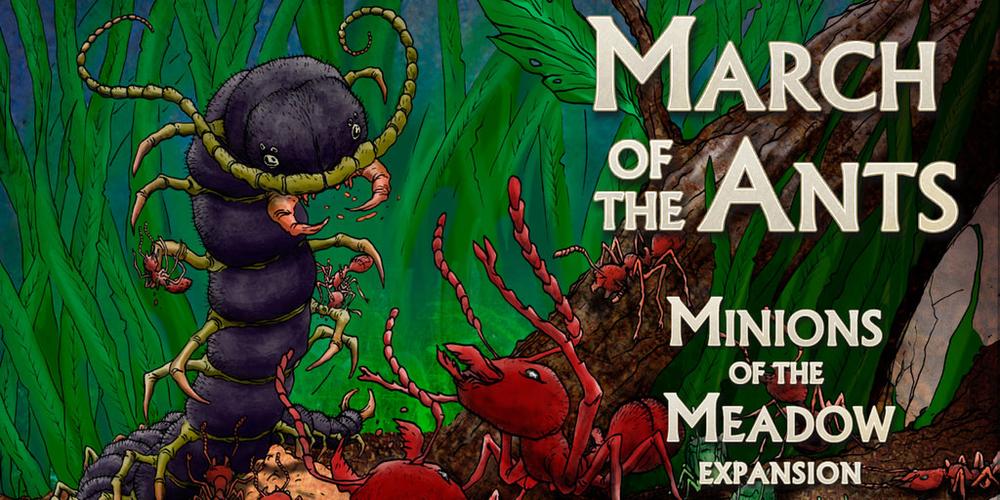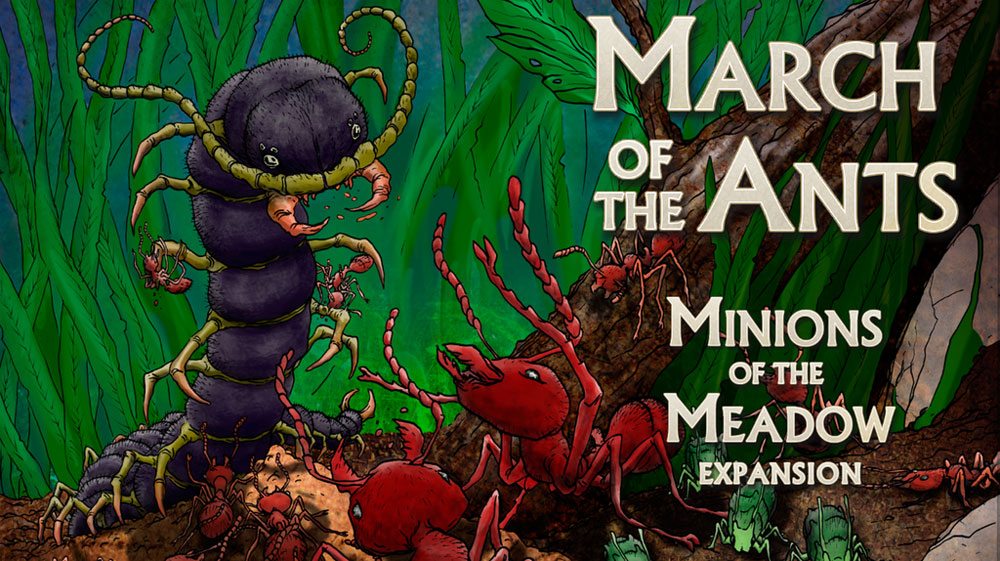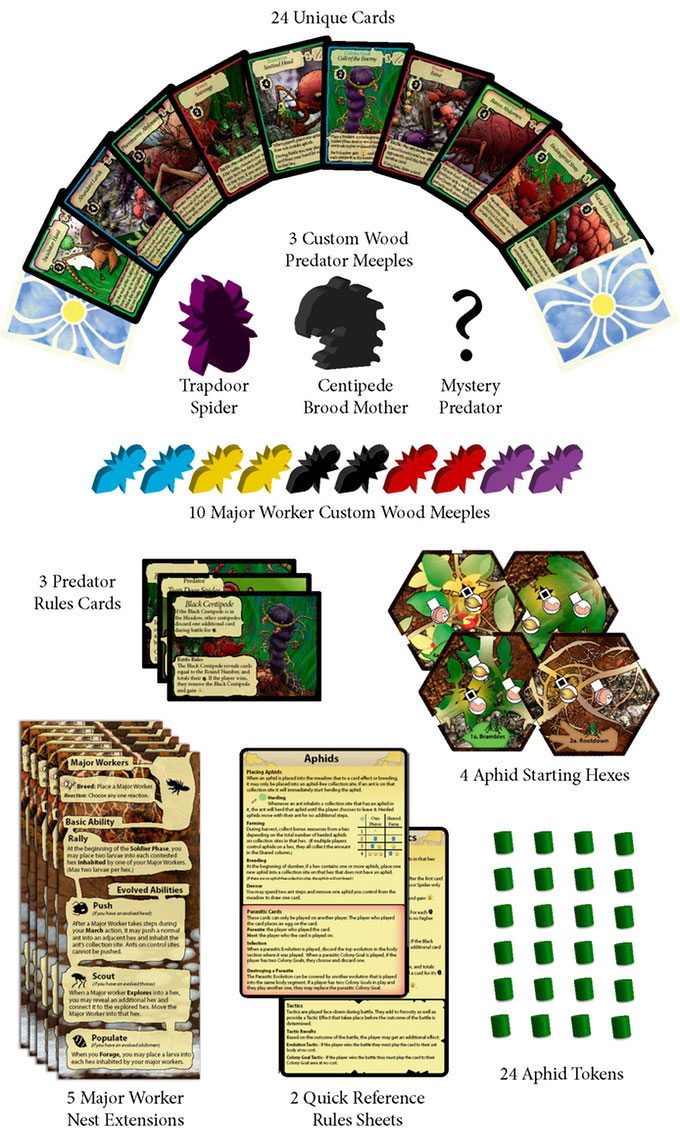The ants are marching on! Breed Major Worker ants, farm aphids, and use Parasitic Evolutions to infect your opponents as you battle for supremacy in the meadow.
At a glance: Minions of the Meadow is the first expansion to March of the Ants from Weird City Games. It’s for 1 to 5 players, ages 13 and up, and takes 60 to 90 minutes to play. (It can be a little longer with the expansion or with a full 5-player game.) It’s currently seeking funding on Kickstarter, with a pledge level of $24 for the expansion. The base game is required to play–you can pledge $35 for just the base game, or $59 for the base game and expansion. March of the Ants is a 4x-style game and can be somewhat complex, so I think the age recommendation is about right; there is nothing inappropriate (other than ant-based violence) for younger kids as far as content.
New to Kickstarter? Check out our crowdfunding primer.
Components
The expansion includes:
- 3 Predator meeples (Trapdoor Spider, Centipede Brood Mother, and a yet-to-be-announced predator)
- 10 Major Worker meeples (2 each in 5 player colors)
- 3 Predator Rules cards
- 4 Aphid starting hexes
- 5 Major Worker Nest extension boards
- 24 Aphid tokens
- 24 cards
- 2 Quick Reference aids
I was able to play a prototype of the game so the pieces were not final (and the 3rd predator was not yet included).
The new cards add a variety of things to the game: There are new Evolution cards, including Parasitic Evolutions that allow you to feed off your opponents in various ways, Tactics that can be played in battle for special effects, and even Parasitic Goal cards that can be played on other players to force them to help you.
The Major Worker board fits next to the base game’s player boards to add in the new abilities for the Major Workers.
The illustrations and designs all match the base game style. I have to admit that, although I do like the illustrations a lot, I’m not as impressed with the graphic design. It’s legible and functional, but doesn’t look polished, and that may bother some people more than others.
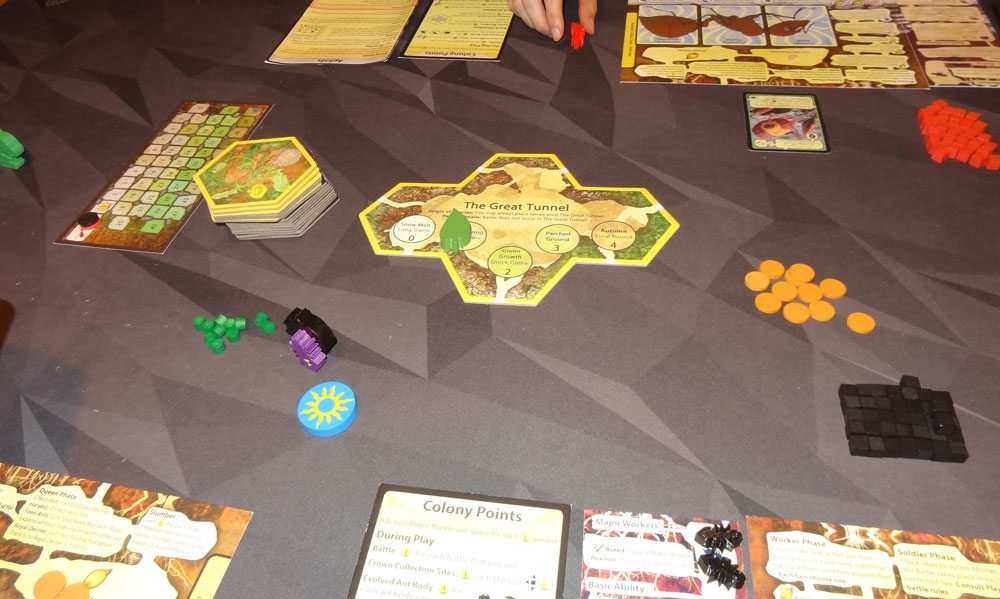
How to Play
The rules to the March of the Ants base game are available here as a PDF, or you can check out my original review here. I’ll explain what’s new in the expansion.
The setup is almost the same. The Aphid Starting Hexes replace some of the Starting Hexes from the base game (one per player, up to all four hexes), and the difference is that they have aphid icons on them. The new cards are shuffled into the deck, and each player gets a Major Worker board and the two Major Worker meeples of their color.
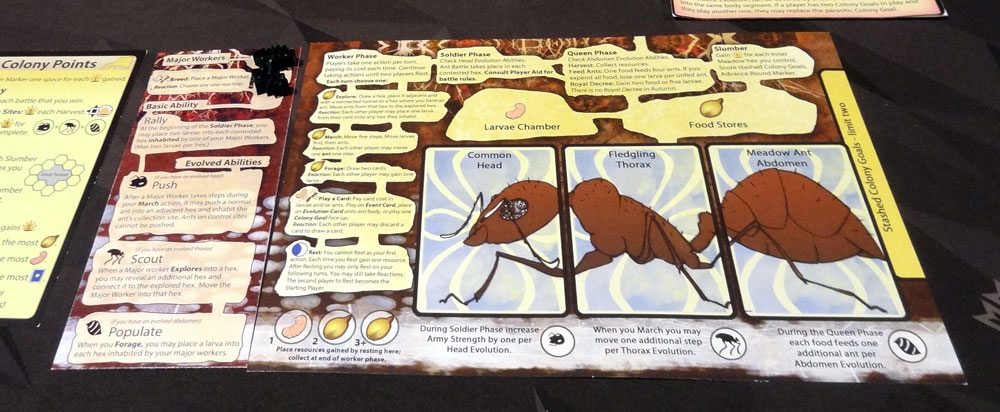
Major Workers
The Major Workers are a new type of ant that you can breed at a cost of two larvae/ants. When you choose this new “Breed Major Worker” action, all other players may choose any reaction ability to follow (as if you had taken one of other basic actions). Major Workers function like regular ants on the board, but they also have some special abilities.
- Rally: During the Soldier phase, you may place 2 larvae (from your Nest) into each contested hex inhabited by a Major Worker.
- Push: If you have an evolved head, whenever you March with a Major Worker, you may push a regular ant out of the hex into an adjacent one and take its collection site.
- Scout: If you have an evolved thorax, whenever you Explore with a Major Worker, you may reveal an additional hex and then you must move the Major Worker into it.
- Populate: If you have an evolved abdomen, whenever you Forage, you may place a larva into each hex inhabited by a Major Worker.

Aphids
When you explore a hex with an Aphid icon on it, the person who explored it puts an aphid token into one of the collection sites on the hex. When an ant is on that collection site, it also picks up the aphid and begins herding it. Aphids automatically move with the ant that is herding it.
During the Harvest phase, any players who are currently herding aphids and are on collection sites will gain bonuses based on the number of aphids on that hex–there are bigger bonuses if you are the only player with aphids in that hex, or shared bonuses if there are multiple players with aphids there. Finally, at the beginning of the Slumber phase, any hex that has aphids (in a collection site) will breed more aphids, if there are collection sites that do not yet have aphids.
You may also use two ant steps (during the Move action) to eat an aphid that you control–you remove the aphid and draw a card.
Parasitic Cards
Several of the new cards–Goals and Evolution–are Parasitic, and these can only be played on another player. When you play a card on somebody, you put one of your own markers on it to indicate that you are the parasite, and the affected player is the host.
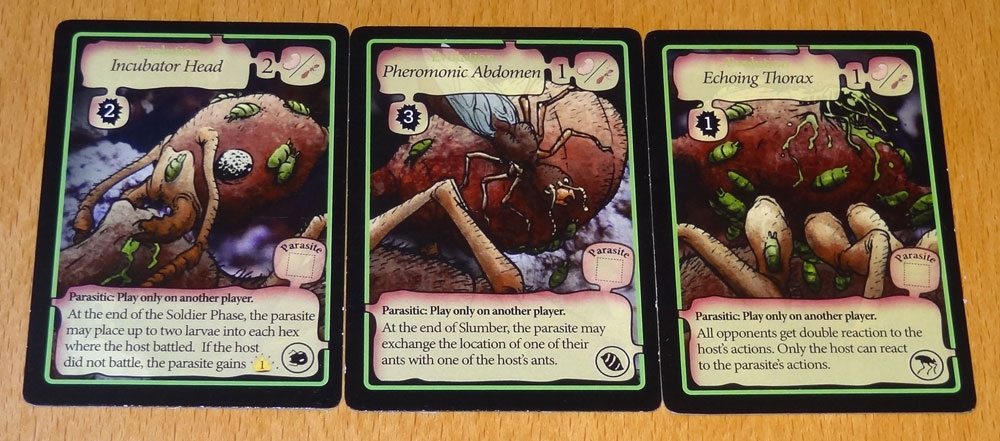
A Parasitic Evolution will infect the top card of its type, discarding it and replacing it. (If that body part has not yet been evolved, you just place the Parasitic Evolution there without discarding anything.) Parasitic Evolutions function the same way as regular Evolutions, granting the same body part bonuses. However, they also grant a bonus to the parasite player. If the host plays another Evolution card of the same body type, it covers up the Parasitic Evolution and no longer benefits the parasite.

Parasitic Colony Goals will take up one of the two Colony Goal spots for another player–if the host already had two Goals in play, they must discard one of them. These Goal cards also have a benefit for the parasite player. They may be replaced by another Goal card only if the host player has two active Goal cards.

Tactics
Tactics cards have no cost, but can only be played during battles. You play a Tactics card face-down as your Ferocity card, and it adds the value shown as your Ferocity–but also has an immediate effect. Some also have an additional bonus depending on the outcome of the battle. For instance, an Evolution Tactics card will allow you to immediately place it as a new Evolution card if you win the battle.
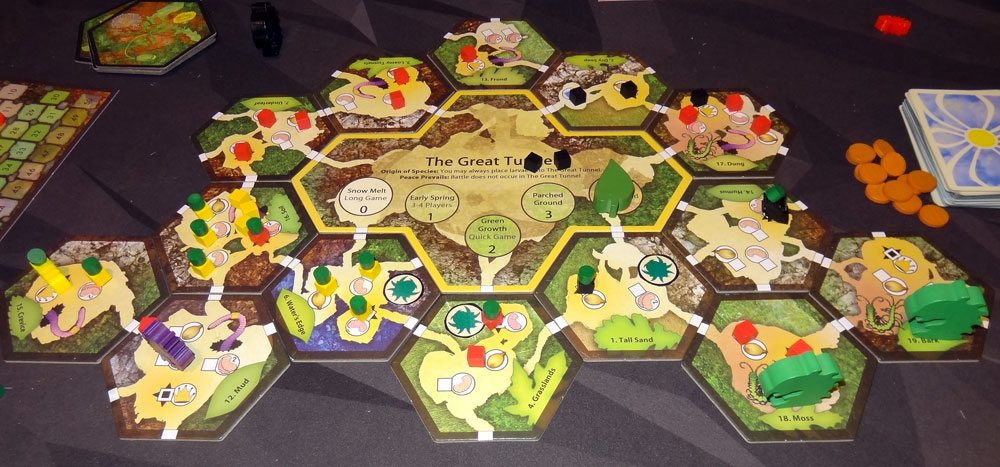
Predators
When the Trapdoor Spider shows up in a hex, it pushes all the ants out of the collection sites so they don’t gain anything during Harvest, but it also traps them so they cannot be moved or used to pay the cost of cards. During battle, the Trapdoor Spider discards 1 card from the deck to determine its base Army Strength, and then 2 more cards after the fighting player optionally discards a card to add Ferocity. The Trapdoor Spider deals 1 casualty whether it wins or loses. If you defeat the Trapdoor Spider, you remove it from the board and gain 2 points. If you lose, the Trapdoor Spider moves at the end of Slumber–flip the top card of the deck and look at the Pow number. The spider moves that many hexes in numerical order. If you run out of numbers, the spider leaves. The spider will battle all players in a hex unless it is defeated.
The Black Centipede is the brood mother. When it is present, all Centipedes get an additional card for Army Strength. The Black Centipede itself will discard cards equal to the round number when it fights, so the later in the game it is, the stronger it gets. Defeating the Black Centipede will earn you 2 points, but then the Centipede still destroys ants equal to half its strength (rounded down).
The Verdict
I actually hadn’t played March of the Ants much since I wrote about the Kickstarter campaign for the base game–just too much other stuff to review in the meantime–but when I sat down to play the expansion I was reminded again how much I enjoy the game. It’s interesting because it is a 4X game, but with a very different theme than you usually see. (Most 4X games I’ve played myself are space-based, with a few set in historical periods.) Here, you explore a meadow, evolve your ant colony, and battle for supremacy.
I really like what the expansion adds to the game–thematically, the idea of harvesting aphids is a lot of fun. In the game, it adds another venue for getting points and cards, and also introduces something new for players to fight over. When a hex with aphids appears on the board, you have to consider how much you want to invest in getting aphids, as opposed to letting somebody else have them and exploring elsewhere.
The Parasitic cards are also a lot of fun–for the parasite, that is. These are cards that may turn friends against you. I do like that being a host usually doesn’t mean you get nothing. You still get a bonus for having the evolved body part, or a chance to earn points for a Colony Goal–but it does mean that somebody else is also leeching off your work. There’s a variety of Parasitic effects, and I think it’s a great way to introduce even more player interaction.
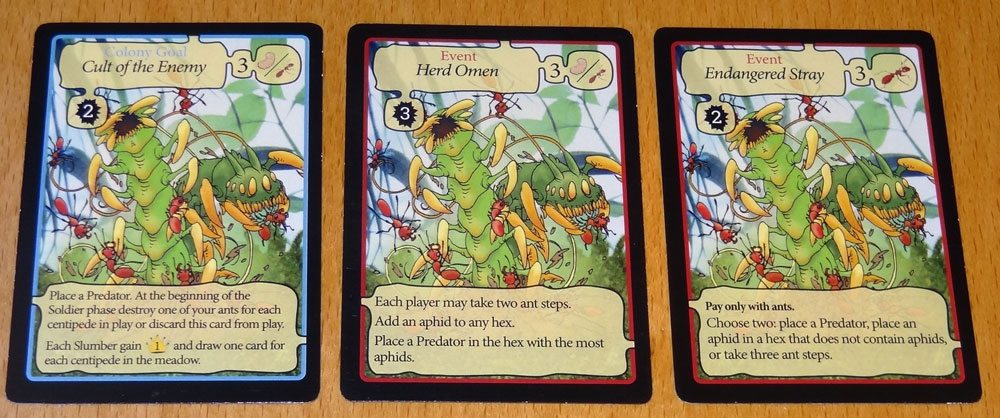
One of the new cards I got to try out is the “Cult of the Enemy” Colony Goal. I drew it early during the game, and decided to go for it. It let me place a Predator on the board, then at the beginning of the Soldier phase I have to destroy one ant for each centipede on the board (or discard the card). But then, during Slumber, I get a point and a card for each centipede in the meadow. Using this card meant I also played other cards to add more centipedes when possible, and that instead of fighting off centipedes I usually just ran away from them. My colony was the smallest on the board because I was always sacrificing ants to them, but I did pretty well in the end, only losing by one point. It was fun to see a completely different strategic path to victory, and I’m curious to see if anyone could win with it.
As I mentioned before, the expansion does add a little to the length of the game, so if you’re playing a 5-player game with the expansion you can expect it to be somewhat lengthy, but the game flows pretty well. Just poke the folks who tend to suffer from analysis paralysis a little or give them a timer if it gets out of hand.
Overall, I’ve really enjoyed March of the Ants and I’m excited about the expansion. I’m not a huge fan of the graphic design of the game, but the gameplay is engaging and you get to make decisions during very player’s turn. Plus, who doesn’t want to rule a colony of ants, right?
Visit the Minions of the Meadow Kickstarter page for more information or to back the project.
